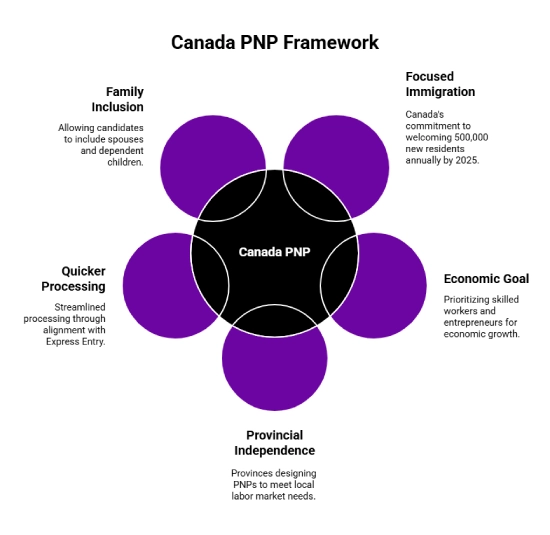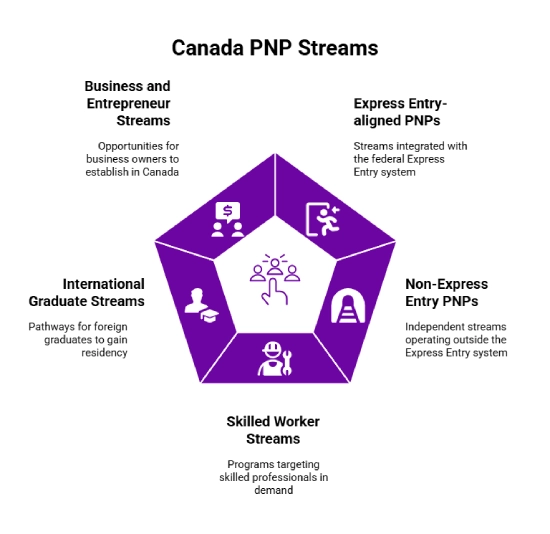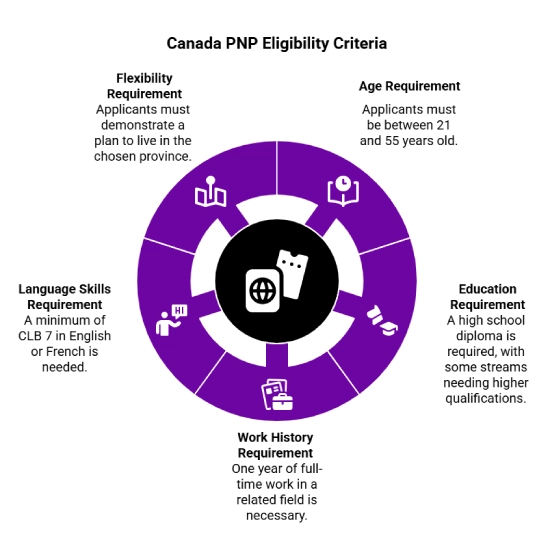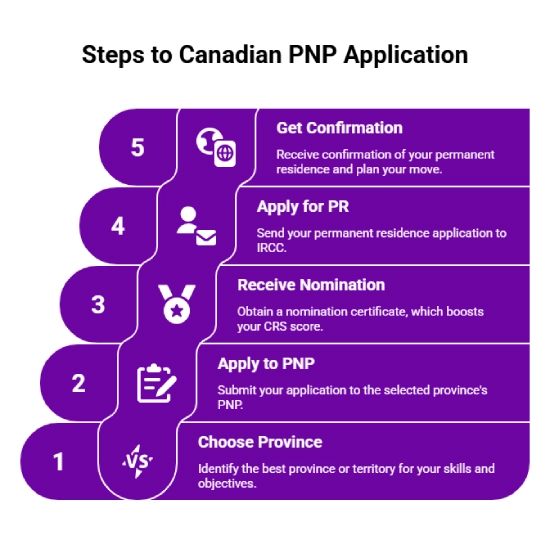Canada Provincial Nominee Program for UK Skilled Workers and Entrepreneurs
Through aligning the capabilities of professionals and entrepreneurs from the UK with particular requirements in its provinces and territories, the Canada Provincial Nominee Program (PNP) provides a direct route to Canadian permanent residency.
- Focused Immigration: Canada intends to accept 500,000 new permanent residents each year by 2025, with a large number coming through PNPs.
- Economic Goal: More than 60% of immigrants are chosen based on economic factors, with an emphasis on qualified workers and entrepreneurs.
- Provincial Independence: To match local labor market demands, each province designs its PNP to offer a range of possibilities.
- Quicker Processing: PNPs aligned with Express Entry can result in speedier processing, frequently within 6 months.
- Family Inclusion: Candidates may add spouses and dependent children to their PNP applications.

What is the Canada PNP?
The Provincial Nominee Program (PNP) allows skilled workers, graduates, and entrepreneurs to immigrate to Canada and become permanent residents. Except for Quebec and Nunavut, each province and territory operates its own PNP to meet local economic and labor demands by attracting suitable individuals.
- Provincial Application: Candidates apply to a specific PNP, showing they meet regional criteria like skills, experience, and language ability.
- Nomination: If a province or territory approves the application, they nominate the candidate for permanent residence.
- Federal Application: The nominee then applies to Immigration, Refugees, and Citizenship Canada (IRCC) for permanent residency, adhering to the processes the province or territory specifies.
Key aspects of PNPs:
- Regional Focus: PNPs tackle the specific labor needs of each province and territory.
- Application Methods: Some PNP options connect to the Express Entry system, while others use traditional paper applications.
- CRS Advantages: A PNP nomination can raise an applicant's Comprehensive Ranking System (CRS) score in the Express Entry pool, increasing chances of receiving an invitation to apply for permanent residence.
- Varied Options: Each PNP provides different streams for skilled workers, international graduates, entrepreneurs, and people with certain work experience.
*Need guidance to apply for Canada immigration? Y-Axis is here to support you with the process.
Benefits of the Canada PNP for UK Residents
The benefits of the Canada PNP are given below.
- Targeted Fields: PNPs aim at specific jobs that are needed, which can help UK applicants in those areas.
- Quicker Applications: PNPs that work with Express Entry can process applications faster, often in about half a year.
- Reduced CRS Scores: If a province nominates you, 600 points are added to your CRS score, making it very likely you will get an ITA.
- Business Immigration: Canada has programs for UK business owners who want to start businesses there.
- Family Immigration: Applicants can include their spouse and children on their application, making it easier for the whole family to move.
Types of Canada PNP Streams
Provincial Nominee Programs in Canada have different streams for various needs and purposed, such as skilled workers, foreign graduates, and business owners. These streams are either connected to the federal Express Entry system or work on their own as base PNPs. Each province's tracks may focus on certain jobs, industries, or areas that need workers.
Some of the popular Canada PNP streams are:
- Express Entry-aligned PNPs
- Non-Express Entry PNPs
- Skilled Worker Streams
- International Graduate Streams
- Business and Entrepreneur Streams

Express Entry-aligned PNPs
Provincial Nominee Programs (PNPs) that align with Canada Express Entry, sometimes called “enhanced” PNPs, provide skilled workers ways to obtain Canadian permanent residence. These options connect to the federal Express Entry system. So, candidates must start by making an Express Entry profile and meeting the criteria for one of the main economic immigration programs handled by Express Entry: the Federal Skilled Worker Program, the Federal Skilled Trades Program, or the Canadian Experience Class.
Non-Express Entry PNPs
The Non-Express Entry Provincial Nominee Program (PNP) gives people a way to immigrate to Canada and become permanent residents if a province or territory nominates them. Instead of the Express Entry system, where candidates are ranked and invited from their profiles, Non-Express Entry PNPs let people apply straight to a province or territory. Application depends on the region's needs and criteria. This option works well for those who do not qualify for or want to use the Express Entry system.
Skilled Worker Streams
Canada has multiple Skilled Worker programs that allow immigrants to get permanent resident status based on their skills and job history. The federal government mainly manages these programs through the Express Entry system. Provinces and territories also run their own programs called Provincial Nominee Programs (PNPs). The federal government also has programs outside Express Entry to meet specific job market demands.
International Graduate Streams
International Graduate Streams are immigration routes under Canadian Provincial Nominee Programs (PNPs). They help international students who've graduated from Canadian schools become permanent residents. These programs give priority to applicants with Canadian education and, in many cases, a job offer.
In January 2025, the British Columbia Provincial Nominee Program (BC PNP) launched three new streams for international graduates. These Bachelor's, Master's, and Doctorate streams replaced the old International Graduate and International Post-Graduate streams and are for graduates with degrees from approved schools.
Business and Entrepreneur Streams
Business and entrepreneurship can be divided into categories based on elements like how big the business is, the kind of innovation used, and its community impact. Key categories include small businesses, startups made to expand, social enterprises, big companies, and innovative ventures. Also, specific fields such as tech businesses, environmentally-friendly businesses, and intrapreneurship show different methods in the wider area.
Popular PNP Provinces for UK Applicants
Many UK applicants want to become permanent residents of Canada. They often apply through Provincial Nominee Programs (PNPs), and some provinces are more commonly chosen.
Some of the popular PNP provinces are given below.
|
PNP Name |
Key Focus Areas |
Ideal For |
|
Ontario Immigrant Nominee Program (OINP) |
Tech, healthcare, finance, skilled trades |
Skilled workers, IT professionals, international grads |
|
Tech, business, tourism, health care |
Tech workers, entrepreneurs, graduates |
|
|
Engineering, energy, agriculture, healthcare |
Skilled workers with ties to Alberta |
|
|
Saskatchewan Immigrant Nominee Program (SINP) |
Agriculture, trades, healthcare, hospitality |
Workers with moderate CRS scores |
|
Manitoba Provincial Nominee Program (MPNP) |
Skilled workers, community connections, entrepreneurs |
Candidates with job offers or Manitoba ties |
|
Nova Scotia Nominee Program (NSNP) |
Healthcare, education, IT, rural development |
Professionals in high-demand sectors |
|
IT, education, transport, bilingual roles |
French/English speakers, skilled workers |
|
|
Agriculture, fisheries, healthcare, hospitality |
Small business owners, rural-focused applicants |
|
|
NL Provincial Nominee Program (NLPNP) |
Tech, oil & gas, skilled trades |
Tech professionals and skilled newcomers |
|
Quebec Skilled Worker Program (QSWP) |
Francophone-focused, IT, health, education |
French-speaking professionals |
Province-Wise PNP Allocations
| Program | 2025 Allocation |
| British Columbia Provincial Nominee Program (BC PNP) | 4,000 (‑50% vs 2024). BC will accept ~1,100 new applications in 2025 and use the rest to clear inventory. |
| Saskatchewan Immigrant Nominee Program (SINP) | 3,625 (province notes a 50% cut and program changes). |
| Manitoba Provincial Nominee Program (MPNP) | 4,750 (2025) |
| New Brunswick Provincial Nominee Program (NBPNP) | No number posted; province confirms significant reductions, controlled reopening (Feb 2025). AIP paused Apr 4, 2025 upon reaching allocation. |
| Newfoundland & Labrador PNP (NLPNP) | 2,050 PNP spaces for 2025 (after federal cuts, NL negotiated an increase from 1,050 to 2,050). |
| Québec Skilled Worker Program (QSWP / PSTQ) | Admissions plan 2025: 48,500–51,500 permanent admissions under regular stream |
Eligibility Criteria for Canada PNP
The eligibility criteria for Canada PNP are given below.
- Age: Usually 21 to 55 years old.
- Education: Must have a high school diploma at least; some streams may need higher qualifications.
- Work History: One year of full-time work in a related field is needed.
- Language Skills: Most streams require a minimum of CLB 7 in either English or French.
- Flexibility: Must show that you plan to and can live in the province you choose.

*Want to check your eligibility for Canada immigration? Use Y-Axis Canada Immigration Points Calculator for FREE and instant results.
Document Requirements for Canada PNP
The documents required to apply for Canada PNP are given below.
- A valid passport and necessary travel papers.
- An Educational Credential Assessment (ECA) report.
- Language test scores from IELTS, CELPIP, or TEF.
- Evidence of work history, like reference letters or pay stubs.
- Certificates of good conduct from the police.
- Medical exam results.
- Proof of sufficient funds, such as bank statements.
- A business plan, if applying through an entrepreneur stream.
Canada PNP Application Process
The procedure to apply for Canada PNP is given below.
Step 1: Determine the Canadian province or territory that best fits your skills, work history, or business objectives.
Step 2: Apply directly to the province’s Provincial Nominee Program (PNP), or make an Express Entry profile if applying via an aligned stream.
Step 3: If your application is approved, you will get a nomination certificate. For Express Entry-aligned streams, this certificate provides 600 points toward your Comprehensive Ranking System (CRS) score.
Step 4: After getting a nomination, send a permanent residence application to Immigration, Refugees and Citizenship Canada (IRCC), either through Express Entry or via mail.
Step 5: IRCC will process your application. If approved, you will get confirmation of your permanent residence and can then plan your move to Canada.

Canada PNP Processing Time
Detailed information about the processing time for Canada PNP is given below.
|
PNP Stream |
Estimated Processing Time |
|
Express Entry-aligned PNPs |
6–8 months |
|
Non-Express Entry PNPs |
15–19 months |
|
Skilled Worker Streams |
6–12 months |
|
International Graduate Streams |
4–10 months |
|
Business and Entrepreneur Streams |
18–30 months |
PNP Process & Delay Insights
In 2025, Canada’s Provincial Nominee Programs (PNPs) are experiencing longer processing times due to reduced federal immigration allocations. Under the new Immigration Levels Plan 2025–2027, the total national PNP target was cut by about 50%, meaning fewer spaces for each province.
Many provinces are now focusing on clearing existing backlogs before inviting new applicants:
-
British Columbia has a 4,000 nomination limit for 2025 and will accept only about 1,100 new applications, using most of its quota to process pending files.
-
Manitoba and Saskatchewan have reduced the size and frequency of their draws to manage smaller allocations.
For applicants, this means:
-
Longer waits between submitting an Expression of Interest (EOI) and receiving an Invitation to Apply (ITA).
-
Some streams may be temporarily paused or issue very few invitations.
-
After receiving a provincial nomination, IRCC’s federal processing for permanent residence can still take several months
Canada PNP Fees and Estimated Costs
Detailed information about the application fee for Canada PNP is given below.
|
PNP Stream |
Provincial Nomination Fee (CAD) |
IRCC Permanent Residence Fee (CAD) |
|
Express Entry-aligned PNPs |
$250 – $1,500 |
$1,365 |
|
Non-Express Entry PNPs |
$250 – $1,500 |
$1,365 |
|
Skilled Worker Streams |
$350 – $1,500 |
$1,365 |
|
International Graduate Streams |
$250 – $1,000 |
$1,365 |
|
Business and Entrepreneur Streams |
$1,000 – $3,500 |
$1,810 |
Stream Breakdown: Express Entry‑Linked vs. Non‑Express Entry PNPs
| Feature | Express Entry‑Linked PNP (Enhanced Streams) | Non‑Express Entry PNP (Base Streams) |
| Connection to federal system | Linked directly to IRCC’s Express Entry system. | Managed entirely by the province/territory outside Express Entry; PR is filed via the non‑EE process. |
| Eligibility | Must meet both the provincial stream criteria and one of the federal EE programs (FSW, FST, CEC). | Must meet the specific province’s criteria (often job offer/employer sponsorship/local ties); no EE eligibility required. |
| CRS points benefit | A provincial nomination in EE gives +600 CRS points, which typically leads to a quick ITA in EE rounds. | No CRS points. After provincial nomination, you submit PR directly to IRCC under the non‑EE PNP route. |
| Processing speed | Faster: IRCC’s service standard targets 6 months for most complete Express Entry PR applications. (Actual times can vary.) | Typically longer than Express Entry; timelines vary by category and volume. Always check IRCC’s Check processing times tool. |
| Examples (official) | BC PNP Skills Immigration streams with EEBC option; Ontario Human Capital Priorities (EE). | BC PNP Skills Immigration (non‑EE options), SK Occupations In‑Demand, MB Skilled Worker pathways (non‑EE). |
Can You Include Family Members in Your PNP Application?
Yes, you can include your family members in your Canada PNP applications. When applying for a Canada PNP, it is usually required to include all dependent family members, even if they are not immigrating with you. This usually means your spouse or common-law partner, dependent children, and any dependent children of your dependent children (grandchildren).
Who can be included:
- Spouse or common-law partner: People who are legally married or in a common-law relationship.
- Dependent children: Biological or adopted children who are under 22 and not married. Children over 22 who can't support themselves due to a physical or mental condition also count.
- Dependent children of dependent children (grandchildren): Grandchildren who fit the requirements of a dependent child.
Not including all family members who are eligible may cause your application to be denied or make it harder to sponsor them in the future.
Pathway to Canada PR and Citizenship
Provincial Nominee Programs in Canada provide a path to Canada PR or permanent residency, leading to citizenship. After a province nominates them, candidates can seek permanent resident status using the Express Entry system or a paper application. To maintain permanent resident status, individuals must reside in Canada for three years out of five, file income taxes, and meet language and legal standards. Upon meeting eligibility criteria, individuals may apply for Canadian citizenship, which involves a citizenship exam and proof of English or French competence. This option suits skilled employees, graduates, and business owners aiming to reside in Canada long term.
Extension, Renewal, or Switching Programs
- Provincial Nominee Programs in Canada have specific time limits and rules, so applicants might need to extend, renew, or change programs as their situation changes.
- Extension: If your nomination is about to expire and you haven't applied for permanent residence, you can ask for more time. The province will decide if they approve it based on your continued eligibility.
- Renewal: You can't usually renew a PNP like a visa. But if your nomination expires, some provinces might let you reapply or give you a new nomination if you still meet their needs.
- Switching Programs: You can change from one PNP stream to another (like from a non-Express Entry stream to Express Entry) or move to federal programs like the Federal Skilled Worker Program. Doing so means meeting new requirements and applying again.
Maintaining open and prompt dialogue with provincial authorities and IRCC is important, especially when delays or changes could have an impact on your eligibility or the time it takes to process your application.
How Can Y-Axis Help You?
Y-Axis provides support to help you deal with changes during your Provincial Nominee Program (PNP) application, keeping your chances for Canadian permanent residency alive.
Our services include:
- Nomination Extension Support: We can help you write and send extension requests to provincial bodies.
- Re-application Tips: We give advice on resending a PNP application if it has run out of time or was denied.
- Program Change Consultation: We help you look at and move to a better PNP or federal immigration path.
- Document Updates & PR Filing: We help update forms, documents, and dates for Immigration, Refugees and Citizenship Canada (IRCC) when your nomination status changes.
- Profile Monitoring: We check your eligibility, Comprehensive Ranking System (CRS) score, and provincial draw updates to respond quickly.
With Y-Axis, you can manage changes to your immigration plan with reliable advice at all times.
Looking for Inspiration
Explore what Global Citizens have to say about Y-Axis in shaping their future
Frequently Asked Questions
